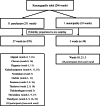A Cross-Sectional Study of the Prevalence and Determinants of Formula-Feeding Practices by Mothers in a Sub-district of Kerala, India
- PMID: 39735131
- PMCID: PMC11682833
- DOI: 10.7759/cureus.74706
A Cross-Sectional Study of the Prevalence and Determinants of Formula-Feeding Practices by Mothers in a Sub-district of Kerala, India
Abstract
Background There is a scarcity of data on formula-feeding practices in India. Therefore, we conducted this study to determine the prevalence and factors associated with formula-feeding practices among mothers of infants in a sub-district of Kerala, India. Methods This community-based cross-sectional study included 300 mothers of infants aged 0-12 months selected using multistage cluster sampling. Data on formula feeding practices were collected at any point during the infant's life through a pre-tested, structured interview schedule. Log-binomial regression analysis was conducted to identify factors associated with formula feeding. Results The mean age of the mothers was 27.06 years (SD: 3.90). Of the participants, 75% (n=225) were graduates or postgraduates, 67.33% (n=202) were homemakers, and 58% (n=174) were above the poverty line (APL). Early initiation of breastfeeding (within one hour of birth) was reported by 65% (n=195) of the mothers. The prevalence of formula feeding among infants under one year was 53.3% [95% Confidence Interval (CI): 47.5-59.1%]. Infants of mothers who delivered in private hospitals [adjusted prevalence ratio (APR): 3.44, 95% CI: 2.47-4.79; p<0.001] and those with a birth weight below 2.5 kg [APR: 1.20, 95% CI: 1.03-1.39; p=0.015] were more likely to be formula-fed compared to their counterparts. Conclusion Formula feeding was observed in over half of the infants in our study. Targeted interventions are essential to reduce formula-feeding practices, especially among low-birth-weight infants and those born in private hospitals.
Keywords: exclusive breast feeding; feeding infants and young children; formula feeding; low birth weight; private hospital.
Copyright © 2024, Bhagyalekshmi et al.
Conflict of interest statement
Human subjects: Consent for treatment and open access publication was obtained or waived by all participants in this study. Amrita School of Medicine, Kochi issued approval ECASM-AIMS-2024-062. Animal subjects: All authors have confirmed that this study did not involve animal subjects or tissue. Conflicts of interest: In compliance with the ICMJE uniform disclosure form, all authors declare the following: Payment/services info: All authors have declared that no financial support was received from any organization for the submitted work. Financial relationships: All authors have declared that they have no financial relationships at present or within the previous three years with any organizations that might have an interest in the submitted work. Other relationships: All authors have declared that there are no other relationships or activities that could appear to have influenced the submitted work.
Similar articles
-
Determinants of infant breastfeeding practices in Nepal: a national study.Int Breastfeed J. 2019 Apr 3;14:14. doi: 10.1186/s13006-019-0208-y. eCollection 2019. Int Breastfeed J. 2019. PMID: 30988689 Free PMC article.
-
Predictors of exclusive breastfeeding in early infancy: operational implications.Indian Pediatr. 1995 Dec;32(12):1287-96. Indian Pediatr. 1995. PMID: 8772886
-
Formula feeding practice and associated factors among mothers with infants 0-6 months of age in Addis Ababa, Ethiopia: a community-based cross-sectional study.Ital J Pediatr. 2021 Mar 9;47(1):55. doi: 10.1186/s13052-021-01010-x. Ital J Pediatr. 2021. PMID: 33750442 Free PMC article.
-
Sub-Optimal Breastfeeding and Its Associated Factors in Rural Communities of Hula District, Southern Ethiopia: A Cross-Sectional Study.Ethiop J Health Sci. 2018 Jan;28(1):49-62. doi: 10.4314/ejhs.v28i1.7. Ethiop J Health Sci. 2018. PMID: 29622907 Free PMC article.
-
Nutrition, growth, and allergic diseases among very preterm infants after hospital discharge.Dan Med J. 2013 Feb;60(2):B4588. Dan Med J. 2013. PMID: 23461996 Review.
References
-
- Infant Formula Preparation and Storage. [ Nov; 2024 ]. 2023. https://www.cdc.gov/nutrition/infantandtoddlernutrition/formula-feeding/... https://www.cdc.gov/nutrition/infantandtoddlernutrition/formula-feeding/...
-
- Infant Formula Market. Pharmacy/ Medical Stores, Specialty Stores, and Others), and Regional Forecast, 2024-2032 [Internet. [ Nov; 2024 ]. 2024. https://www.fortunebusinessinsights.com/amp/industry-reports/infant-form... https://www.fortunebusinessinsights.com/amp/industry-reports/infant-form...
LinkOut - more resources
Full Text Sources
Miscellaneous

